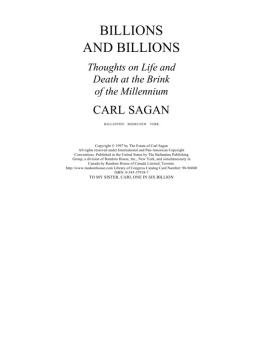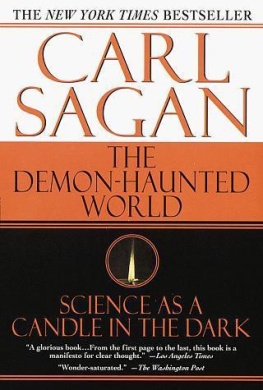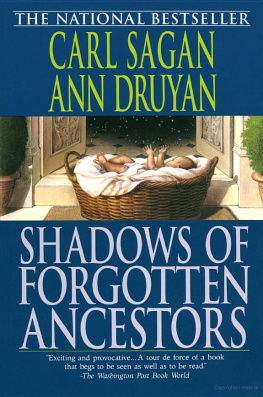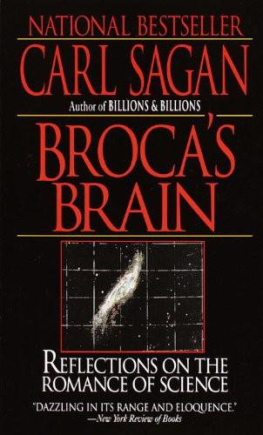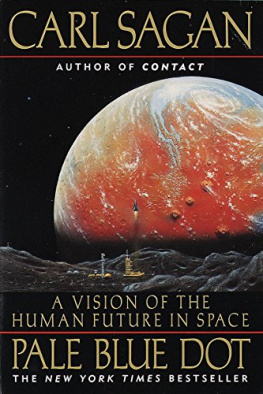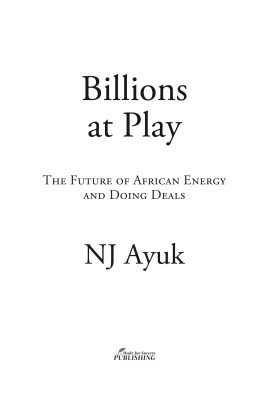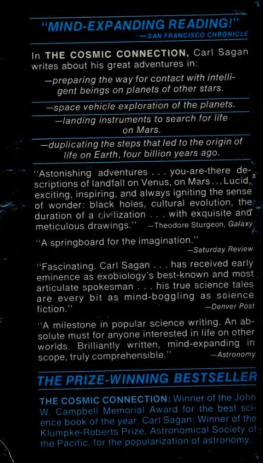Carl Sagan - Billions and Billions: Thoughts on Life and Death at the Brink of the Millennium
Here you can read online Carl Sagan - Billions and Billions: Thoughts on Life and Death at the Brink of the Millennium full text of the book (entire story) in english for free. Download pdf and epub, get meaning, cover and reviews about this ebook. year: 1998, publisher: Ballantine Books, genre: Children. Description of the work, (preface) as well as reviews are available. Best literature library LitArk.com created for fans of good reading and offers a wide selection of genres:
Romance novel
Science fiction
Adventure
Detective
Science
History
Home and family
Prose
Art
Politics
Computer
Non-fiction
Religion
Business
Children
Humor
Choose a favorite category and find really read worthwhile books. Enjoy immersion in the world of imagination, feel the emotions of the characters or learn something new for yourself, make an fascinating discovery.
- Book:Billions and Billions: Thoughts on Life and Death at the Brink of the Millennium
- Author:
- Publisher:Ballantine Books
- Genre:
- Year:1998
- Rating:4 / 5
- Favourites:Add to favourites
- Your mark:
- 80
- 1
- 2
- 3
- 4
- 5
Billions and Billions: Thoughts on Life and Death at the Brink of the Millennium: summary, description and annotation
We offer to read an annotation, description, summary or preface (depends on what the author of the book "Billions and Billions: Thoughts on Life and Death at the Brink of the Millennium" wrote himself). If you haven't found the necessary information about the book — write in the comments, we will try to find it.
Carl Sagan: author's other books
Who wrote Billions and Billions: Thoughts on Life and Death at the Brink of the Millennium? Find out the surname, the name of the author of the book and a list of all author's works by series.
Billions and Billions: Thoughts on Life and Death at the Brink of the Millennium — read online for free the complete book (whole text) full work
Below is the text of the book, divided by pages. System saving the place of the last page read, allows you to conveniently read the book "Billions and Billions: Thoughts on Life and Death at the Brink of the Millennium" online for free, without having to search again every time where you left off. Put a bookmark, and you can go to the page where you finished reading at any time.
Font size:
Interval:
Bookmark:
BILLIONS
AND BILLIONS
Thoughts on Life and
Death at the Brink
of the Millennium
CARL SAGAN
BALLANTINE BOOKS NEW YORK
Copyright 1997 by The Estate of Carl Sagan
All rights reserved under International and Pan-American Copyright Conventions. Published in the United States by The Ballantine Publishing Group, a division of Random House, Inc., New York, and simultaneously in Canada by Random House of Canada Limited, Toronto.
http://www.randomhouse.com Library of Congress Catalog Card Number: 98-96080
ISBN: 0-345-37918-7
TO MY SISTER, CARI, ONE IN SIX BILLION
Contents
List of Illustrations .....
PART I THE POWER AND BEAUTY OF QUANTIFICATION
1. Billions and Billions
2. The Persian Chessboard
3. Monday-Night Hunters
4. The Gaze of God and the Dripping Faucet
5. Four Cosmic Questions
6. So Many Suns, So Many Worlds
PART II WHAT ARE CONSERVATIVES CONSERVING?
7. The World That Came in the Mail
8. The Environment: Where Does Prudence Lie?
x Contents 9. Croesus and Cassandra
10. A Piece of the Sky Is Missing
11. Ambush: The Warming of the World
12. Escape from Ambush
13. Religion and Science: An Alliance
PART III WHERE HEARTS AND MINDS COLLIDE
14. The Common Enemy
15. Abortion: Is It Possible to Be Both "Pro-Life"
and "Pro-Choice"? (cowritten with Ann Druyan)
16. The Rules of the Game
17. Gettysburg and Now (cowritten with Ann Druyan)
18. The Twentieth Century
19. In the Valley of the Shadow
Epilogue by Ann Druyan
Index
List of Illustrations
Photograph of Carl Sagan with Johnny Carson on the Tonight show,May 30, 1980 .....
Counting big numberssix sketches by Patrick McDonnell
The Grand Vizier's rewardthree sketches by Patrick McDonnellExponential growth in bacterial population, showing the flattening of the curveExponential growth in human population, showing the flattening of the curveRipples in water on the surface of a lake, showing the wave pattern 40 The electromagnetic wavespectrumnote the small portion that we
experience as visible light
Surface-reflectance properties of ordinary pigments in visible light ..52 Carbon dioxide concentrations inEarth's atmosphere over time ..127 Timeline of global temperaturesGreenhouse Warmingsketch by Patrick McDonnell
Nuclear Powersketch by Patrick McDonnell
xii List of Illustrations
Solar Energysketch by Patrick McDonnell
Human fetal developmentdrawings showing fetus at conception and at three weeksHuman fetal developmentdrawings showing fetus at five weeks and at sixteen weeksHuman fetal developmentdrawings showing resemblance of a human fetus to, in succession, a worm, anamphibian, a reptile, and a primate
THE POWER
AND BEAUTY OF
QUANTIFICATION
There are some... who think that the number of [grains of] sand is infinite.... There are some who, without regarding it as infinite, yet think no number has been named which is great enough.... But I will try to show you
[numbers that] exceed not only the number of the mass of sand equal to the Earth filled up ... but also that of a mass equal in magnitude to the Universe.
ARCHIMEDES (CA. 28y-2I2 B.C.),
The Sand-Reckoner
I never said it. Honest. Oh, I said there are maybe 100 billion galaxies and 10 billion trillion stars. It's hard to talk about the Cosmos without using big numbers. I said "billion" many times on the Cosmos television series, which was seen by a great many people. But I never said "billions and billions." For one thing, it's too imprecise. How many billions are "billions and billions"? A few billion? Twenty billion? A hundred billion? "Billions and billions" is pretty vague. When we reconfigured and updated the series, I checkedand sure enough, I never said it.
But Johnny Carsonon whose Tonight Show I'd appeared almost thirty times over the yearssaid it.
He'd dress up in a corduroy jacket, a turtleneck sweater, and something like a mop for a wig. He had created a rough imitation of me, a kind of Doppelganger, that went around saying "billions and billions"
on late-night television. It used to bother me a little to have some simulacrum of my persona wandering off on its own, saying things that friends and colleagues would report to me the next morning. (Despite the disguise, Carsona serious amateur astronomerwould often make my imitation talk real science.) Astonishingly, "billions and billions" stuck. People liked the sound of it. Even today, I'm stopped on the street or on an airplane or at a party and asked, a little shyly, if I wouldn't-just for themsay "billions and billions."
"You know, I didn't actually say it," I tell them.
"It's okay," they reply. "Say it anyway."
I'm told that Sherlock Holmes never said, "Elementary, my dear Watson" (at least in the Arthur Conan Doyle books); Jimmy Cagney never said, "You dirty rat"; and Humphrey Bogart never said, "Play it again, Sam." But they might as well have, because these apocrypha have firmly insinuated themselves into popular culture.
I'm still quoted as uttering this simple-minded phrase in computer magazines ("As Carl Sagan would say, it takes billions and billions of bytes"), newspaper economics primers, discussions of players' salaries in professional sports, and the like.
For a while, out of childish pique, I wouldn't utter or write the phrase, even when asked to. But I've gotten over that. So, for the record, here goes:
"Billions and billions."
What makes "billions and billions" so popular? It used to be that "millions" was the byword for a large number. The enormously rich were millionaires. The population of the Earth at the time of Jesus was perhaps 250 million people. There were almost 4 million Americans at the time of the Constitutional Convention of 1787; by the beginning of World War II, there were 132 million. It is 93 million miles
'(150 million kilometers) from the Earth to the Sun. Approximately 40 million people were killed in World War I; 60 million in World War II. There are 31.7 million seconds in a year (as is easy enough to verify). The global nuclear arsenals at the end of the 1980s contained an equivalent explosive power sufficient to destroy 1 million Hiroshimas. For many purposes and for a long time, "million" was the quintessential big number.
But times have changed. Now the world has a clutch of Millionairesand not just because of inflation.
The age of the Earth is well-established at 4.6 billion years. The human population is pushing 6 billion people. Every birthday represents another billion kilometers around the Sun (the Earth is traveling around the Sun much faster than the Voyager spacecraft are traveling away from the Earth). Four B-2 bombers cost a billion dollars. (Some say 2 or even 4 billion.) The U.S. defense budget is, when hidden costs are accounted for, over $300 billion a year. The immediate fatalities in an all-out nuclear war between the United States and Russia are estimated to be around a billion people. A few inches are a billion atoms side by side. And there are all those billions of stars and galaxies.
In 1980, when the Cosmos television series was first shown, people were ready for billions. Mere millions had become a little downscale, unfashionable, miserly. Actually, the two words sound sufficiently alike that you have to make a serious effort to distinguish them. This is why, in Cosmos, I pronounced
Next pageFont size:
Interval:
Bookmark:
Similar books «Billions and Billions: Thoughts on Life and Death at the Brink of the Millennium»
Look at similar books to Billions and Billions: Thoughts on Life and Death at the Brink of the Millennium. We have selected literature similar in name and meaning in the hope of providing readers with more options to find new, interesting, not yet read works.
Discussion, reviews of the book Billions and Billions: Thoughts on Life and Death at the Brink of the Millennium and just readers' own opinions. Leave your comments, write what you think about the work, its meaning or the main characters. Specify what exactly you liked and what you didn't like, and why you think so.

